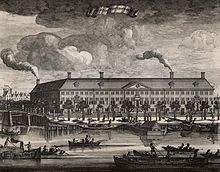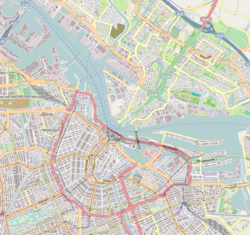H'ART Museum: Difference between revisions
→History: lang-en; and delink per WP:overlink |
change photo |
||
| Line 37: | Line 37: | ||
The building was opened in 1682 as a [[retirement home]] for elderly women, and was named Diaconie Oude Vrouwen Huys ([[English language|English]]: Deanery Home for Old Women). The building is located on the east bank of the river [[Amstel]]. Since 1817, the home was open for both elderly men and women, and it was renamed Diaconie Oude Vrouwen- en Mannenhuis (English: Deanery Home for Old Men and Women). The building was first named [[Amstelhof]] ({{lang-en|Amstel Court}}]) in 1953.<ref>http://www.hermitage.nl/en/hermitage_amsterdam/geschiedenis_van_het_gebouw.htm</ref> |
The building was opened in 1682 as a [[retirement home]] for elderly women, and was named Diaconie Oude Vrouwen Huys ([[English language|English]]: Deanery Home for Old Women). The building is located on the east bank of the river [[Amstel]]. Since 1817, the home was open for both elderly men and women, and it was renamed Diaconie Oude Vrouwen- en Mannenhuis (English: Deanery Home for Old Men and Women). The building was first named [[Amstelhof]] ({{lang-en|Amstel Court}}]) in 1953.<ref>http://www.hermitage.nl/en/hermitage_amsterdam/geschiedenis_van_het_gebouw.htm</ref> |
||
For centuries, the building was used as a retirement home. Due to modernizations in healthcare, the building was no longer sufficient. The building was transformed into the museum when the last inhabitants left the Amstelhof in 2007.<ref>http://www.hermitage.nl/en/hermitage_amsterdam/van_amstelhof_naar_hermitage_amsterdam.htm</ref> On |
For centuries, the building was used as a retirement home. Due to modernizations in healthcare, the building was no longer sufficient. The building was transformed into the museum when the last inhabitants left the Amstelhof in 2007.<ref>http://www.hermitage.nl/en/hermitage_amsterdam/van_amstelhof_naar_hermitage_amsterdam.htm</ref> On 20 June 2009, the whole museum was opened by Dutch [[Beatrix of the Netherlands|Queen Beatrix]] and [[Russian President]] [[Dmitry Medvedev]]. The museum was open to the public the following day.<ref>Reuters.com - [http://www.reuters.com/article/lifestyleMolt/idUSTRE55H6OC20090618 Russia's Hermitage museum opens Amsterdam branch]</ref><ref>{{nl icon}} http://www.nrc.nl/kunst/article2277306.ece/Hermitage_Adam_geopend</ref> |
||
Already on 24 February 2004, a small museum was opened in an adjacent building on the Nieuwe Keizersgracht. This museum temporary closed in 2008 in order to be transformed into the Hermitage for Children. It opened on the same day as the rest of the Hermitage to the public, on 20 June 2009. |
Already on 24 February 2004, a small museum was opened in an adjacent building on the Nieuwe Keizersgracht. This museum temporary closed in 2008 in order to be transformed into the Hermitage for Children. It opened on the same day as the rest of the Hermitage to the public, on 20 June 2009. |
||
==Exhibitions== |
==Exhibitions== |
||
[[File:Dmitry Medvedev in the Netherlands 20 June 2009-5.jpg|thumb|[[Russian President]] [[Dmitry Medvedev]] and [[Beatrix of the Netherlands|Queen Beatrix]] at the official opening of Hermitage Amsterdam on 20 June 2009.]]]] |
|||
[[File:Hermitagebinnen1.jpg|thumb|Artist impression of the interior of the museum]] |
|||
There are two permanent presentations, one about [[Netherlands–Russia relations]] and the other about the history of the building [[Amstelhof]].<ref>http://www.hermitage.nl/en/pers/2e_fase/persberichten/informatie_vaste_presentaties.htm</ref> In the rest of the museum is a temporary exhibition of half a year.<ref>http://www.hermitage.nl/en/pers/2e_fase/persberichten/jaarprogramma.htm</ref> |
There are two permanent presentations, one about [[Netherlands–Russia relations]] and the other about the history of the building [[Amstelhof]].<ref>http://www.hermitage.nl/en/pers/2e_fase/persberichten/informatie_vaste_presentaties.htm</ref> In the rest of the museum is a temporary exhibition of half a year.<ref>http://www.hermitage.nl/en/pers/2e_fase/persberichten/jaarprogramma.htm</ref> |
||
Revision as of 01:55, 4 May 2011
 Entrance of the museum | |
| Established | 2004 |
|---|---|
| Location | Amsterdam, Netherlands |
| Type | Art museum |
| Visitors | 630,000 (2009)[1]
|
| Director | Ernst Veen |
| Public transit access | Waterlooplein metro station, Nieuwe Herengracht exit |
| Website | www.hermitage.nl |
Hermitage Amsterdam is a dependency of the Hermitage Museum of Saint Petersburg on the Amstel river in Amsterdam. The dependency is located at the former Amstelhof, a classical style building from 1681. The dependency has been displaying small exhibitions in a side building next to the Amstelhof since 24 February 2004. The full museum was opened on 19 June 2009.
It is currently the largest dependency of the Hermitage Museum,[3] with the total area of the building numbering 12,846 square metres (138,270 sq ft), and the exhibition area 2,172 square metres (23,380 sq ft) (two big exhibition halls and exhibition rooms).[4]
History

The building was opened in 1682 as a retirement home for elderly women, and was named Diaconie Oude Vrouwen Huys (English: Deanery Home for Old Women). The building is located on the east bank of the river Amstel. Since 1817, the home was open for both elderly men and women, and it was renamed Diaconie Oude Vrouwen- en Mannenhuis (English: Deanery Home for Old Men and Women). The building was first named Amstelhof (Template:Lang-en]) in 1953.[5]
For centuries, the building was used as a retirement home. Due to modernizations in healthcare, the building was no longer sufficient. The building was transformed into the museum when the last inhabitants left the Amstelhof in 2007.[6] On 20 June 2009, the whole museum was opened by Dutch Queen Beatrix and Russian President Dmitry Medvedev. The museum was open to the public the following day.[7][8]
Already on 24 February 2004, a small museum was opened in an adjacent building on the Nieuwe Keizersgracht. This museum temporary closed in 2008 in order to be transformed into the Hermitage for Children. It opened on the same day as the rest of the Hermitage to the public, on 20 June 2009.
Exhibitions

]]
There are two permanent presentations, one about Netherlands–Russia relations and the other about the history of the building Amstelhof.[9] In the rest of the museum is a temporary exhibition of half a year.[10]
Matisse to Malevich
- Matisse to Malevich. Pioneers of Modern Art from the Hermitage van 6 March t/m 17 September 2010 [11]
The Hermitage Museum of Saint Petersburg has one of the finest collections of French painting from the end of the 19th and the beginning of the 20th century. This remarkable part of the collection comprises hundreds of masterpieces by artists regarded as pioneers of Modernism, including Matisse, Van Dongen, De Vlaminck, Derain and Picasso. The exhibition places the concept of Modernism in a historical perspective and looks at how artists took part in this revolutionary movement. This collection originated with the renowned Russian collectors Morozov and Shchukin. For the first time highlights of this ‘modern’ collection of French art from the Hermitage will be seen in the Netherlands, in an exhibition unequalled among Dutch museums. In the future a second exhibition will go into the origins of this modern art on the basis of a rich selection from the famous Impressionists in the Hermitage. The guest curator is Henk van Os, University Professor at the University of Amsterdam and chairman of the Specialists Council of the Hermitage Amsterdam.
The immortal Alexander the Great
- The immortal Alexander the Great The Myth, The Truth, His Journey, His Legacy 18 September 2010 - 18 March 2011.
No ruler in antiquity appeals to the imagination as much as Alexander the Great (356 BC – 323 BC, king from 336 BC). From his youth he inspired the people around him. During his campaigns in the East, Alexander went in search of the origins of Dionysus, who, according to the ancient Greeks, came from the exotic East, possibly India. Alexander followed in Dionysus’s footsteps and reached many countries: Egypt, Syria, Bactria, Persia, India and Mongolia. Everywhere he founded new capitals and named them all Alexandria. He left behind a legacy of Greek culture in the form of Hellenism. His fame lived on, long after antiquity. He was an example to many European, Russian and Islamic rulers. Paintings, tapestries and decorative art depicted Alexander’s life and history. The exhibition covers all these aspects, with objects from classical antiquity to the modern age, of Western and non-Western origins.
References
- ^ Template:Nl icon Hermitage Amsterdam sinds opening 20 juni 2009: 630.000 bezoekers. Hermitage Amsterdam. Retrieved on 2010-12-23.
- ^ Template:Nl icon Musea hebben lak aan recessie. DagjeWeg.nl. Retrieved on 2010-12-23.
- ^ Hermitage website - The formal opening of the Hermitage • Amsterdam Centre: Mikhail Piotrovsky is quoted as saying: "[The dependency in Amsterdam] is a part of the global strategy of the Hermitage to make our collections available in the world. We are organizing different centres. This centre is the largest."
- ^ Hermitage website - The Hermitage Amsterdam Centre - History of the project
- ^ http://www.hermitage.nl/en/hermitage_amsterdam/geschiedenis_van_het_gebouw.htm
- ^ http://www.hermitage.nl/en/hermitage_amsterdam/van_amstelhof_naar_hermitage_amsterdam.htm
- ^ Reuters.com - Russia's Hermitage museum opens Amsterdam branch
- ^ Template:Nl icon http://www.nrc.nl/kunst/article2277306.ece/Hermitage_Adam_geopend
- ^ http://www.hermitage.nl/en/pers/2e_fase/persberichten/informatie_vaste_presentaties.htm
- ^ http://www.hermitage.nl/en/pers/2e_fase/persberichten/jaarprogramma.htm
- ^ Matisse to Malevich. Pioneers of Modern Art from the Hermitage
External links
- Hermitage Amsterdam, official website
- Section on the Amsterdam Hermitage on the official Hermitage Museum website

